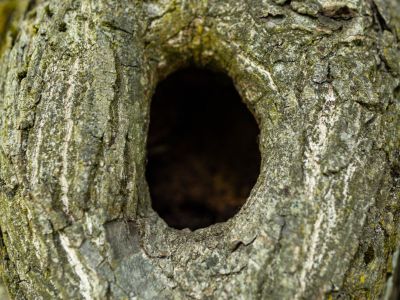Will Trees With Holes Die?
The short answer to this is probably not. When a tree develops a hole or if that hole gets larger and creates a hollow tree, most of the time, it is only the heartwood that is affected. The tree only needs the bark and the first few layers beneath the bark to live. These outer layers will often be protected by their own barriers from the rot that creates hollows and holes inside the trees. As long as your tree looks healthy, it is unlikely that the hole in the tree will harm it. When you find holes and hollows, you need to make sure that you do not damage the outer layers of the tree in the areas of the holes. This can cause damage to the natural barrier and allow the rot to get into the essential outer layers of the trunk, which then can kill the tree.
Is a Tree With a Hollow Trunk a Danger?
Sometimes hollow trees are a danger and sometimes they are not. The heartwood of the tree is technically dead, but it does provide important structural support to the trunk and canopy above. If the area where the tree has been hollowed out is still structurally sound, the tree is not a danger. Remember, a strong storm can put extra pressure on a tree and a tree that seems structurally sound in normal conditions may not be able to withstand the extra stress of high winds. If you are uncertain if the hollow tree is stable enough, have a professional arborist examine the tree. Also, be aware that studies have shown that filling in a hollow tree often does not improve the stability of the tree. Do not rely on simply filling in a hollow tree as a suitable way to make a tree more stable. Remember to recheck a hollow tree regularly to make sure that it is still structurally sound.
Is Filling Holes in Tree Trunks a Good Idea?
In the past, it was often recommended that filling holes in tree trunks was a good way to correct the tree hole. Most tree experts now agree that this advice was incorrect. Filling holes in trees causes problems for several reasons. The material that you fill the tree hole with will not react to the weather in the same way the tree wood will. The material you use will expand and contract at a different rate, which will either cause more damage to the tree or can create gaps where water (which leads to more rot) and disease can get trapped. Not only that, but if the tree must be removed at a later date, fill materials can create dangerous situations to the person removing the tree. Imagine if someone using a chainsaw were to hit a concrete fill that they were not aware of in the tree. If you have decided that filling a hole in a tree trunk is your best option, make sure that you use a softer material, such as expanding foam, to do so.
How to Patch a Hole in a Tree Trunk
The recommended method for patching a tree hole is to use a thin metal flap or screening covered with plaster over the tree hole. This will prevent animals and water from entering the hole and create a surface that the bark and outer living layers can eventually grow back over. Before patching a tree hole, it is a good idea to remove any water from the hole and any soft rotted wood. Do not remove any wood that is not soft as this can damage the outer layer of the tree and allow disease and rot to enter the living part of the tree.
